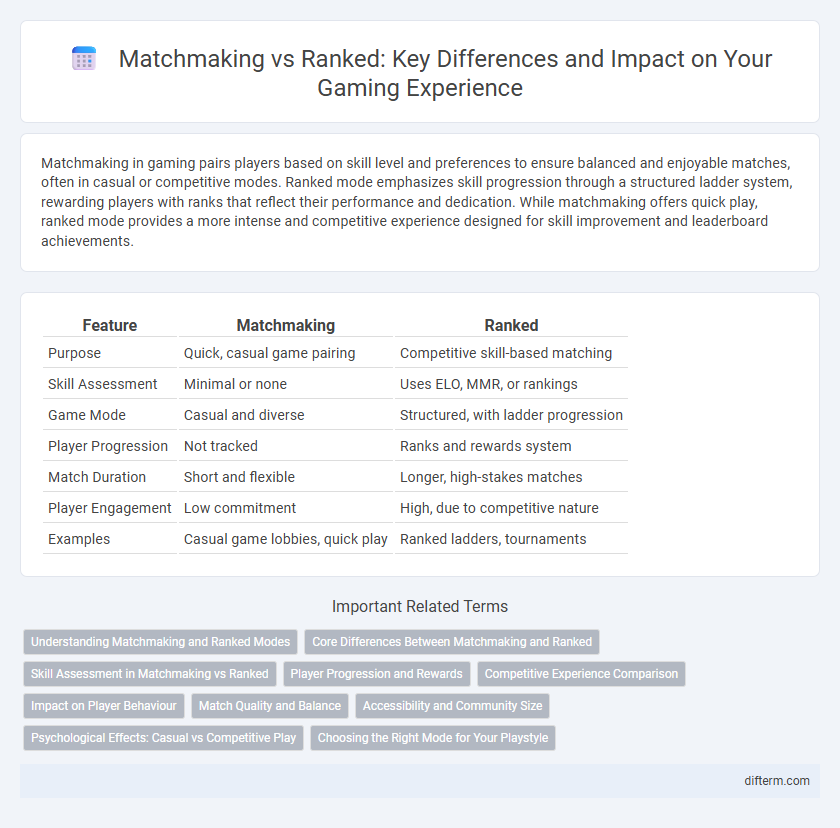Matchmaking in gaming pairs players based on skill level and preferences to ensure balanced and enjoyable matches, often in casual or competitive modes. Ranked mode emphasizes skill progression through a structured ladder system, rewarding players with ranks that reflect their performance and dedication. While matchmaking offers quick play, ranked mode provides a more intense and competitive experience designed for skill improvement and leaderboard achievements.
Table of Comparison
| Feature | Matchmaking | Ranked |
|---|---|---|
| Purpose | Quick, casual game pairing | Competitive skill-based matching |
| Skill Assessment | Minimal or none | Uses ELO, MMR, or rankings |
| Game Mode | Casual and diverse | Structured, with ladder progression |
| Player Progression | Not tracked | Ranks and rewards system |
| Match Duration | Short and flexible | Longer, high-stakes matches |
| Player Engagement | Low commitment | High, due to competitive nature |
| Examples | Casual game lobbies, quick play | Ranked ladders, tournaments |
Understanding Matchmaking and Ranked Modes
Matchmaking in gaming pairs players based on skill level, latency, and behavioral metrics to ensure fair and balanced gameplay, promoting a more enjoyable experience for casual or competitive sessions. Ranked modes provide a structured competitive environment where players earn points or tiers reflecting their performance, encouraging continuous improvement and skill mastery. Understanding the differences helps gamers choose the right mode for their preferences and track progress effectively within the game's ecosystem.
Core Differences Between Matchmaking and Ranked
Matchmaking in gaming provides a casual experience by pairing players based on general skill levels and preferences, promoting balanced gameplay without intense competition. Ranked mode emphasizes competitive play, using a rigorous ranking system that adjusts player ratings based on performance and match outcomes to foster skill progression. The core difference lies in matchmaking's relaxed environment versus ranked's structured ladder designed for players seeking serious challenges and recognition.
Skill Assessment in Matchmaking vs Ranked
Matchmaking systems prioritize dynamic skill assessment to create balanced matches by analyzing player performance metrics in real-time, ensuring fair competition regardless of rank. Ranked modes implement a structured skill rating system, often using Elo or MMR (Matchmaking Rating), to place players within a hierarchical ladder reflecting long-term skill progression. This distinction enables matchmaking to offer varied gameplay experiences, while ranked modes maintain competitive integrity through consistent player evaluation and progression tracking.
Player Progression and Rewards
Matchmaking systems balance player skills to create fair and engaging matches, promoting gradual player progression through adaptive challenges. Ranked modes offer a structured ladder where skill tiers reflect player improvement, providing exclusive rewards such as badges, skins, and in-game currency. Player progression in ranked environments is often more competitive, driving motivation through clear milestones and tangible incentives.
Competitive Experience Comparison
Matchmaking offers a more casual and flexible competitive experience with a wider pool of opponents, allowing players to practice and improve at their own pace. Ranked mode provides a structured environment where skill-based tiers and leaderboards drive intense competition and progression. The choice between matchmaking and ranked impacts player motivation, with ranked modes emphasizing performance under pressure and matchmaking favoring experimental playstyles.
Impact on Player Behaviour
Matchmaking systems in gaming foster diverse player interactions by pairing individuals based on skill and latency, which often leads to balanced and enjoyable experiences without intense pressure. Ranked modes escalate competition through skill-based progression and visible rankings, significantly influencing player behavior by increasing strategic play, commitment, and sometimes causing frustration or toxicity due to higher stakes. Understanding these dynamics helps developers design features that promote fair play and positive community engagement in both casual and competitive environments.
Match Quality and Balance
Matchmaking systems prioritize match quality by pairing players with similar skill levels to ensure balanced and competitive gameplay, reducing the likelihood of one-sided matches. Ranked modes emphasize player progression and skill differentiation, often leading to more intense and strategic encounters but sometimes sacrificing balance for skill disparity within skill tiers. Effective matchmaking algorithms continuously analyze player performance metrics to maintain equilibrium and enhance the overall gaming experience.
Accessibility and Community Size
Matchmaking in gaming offers broader accessibility, allowing players of all skill levels to join games quickly, fostering a larger and more diverse community size. Ranked modes, while catering to competitive players seeking skill-based matchmaking, typically feature a narrower player pool due to higher entry barriers and stricter requirements. The accessibility of casual matchmaking promotes inclusivity and vibrant community interactions, whereas ranked modes emphasize competitive integrity and skill progression.
Psychological Effects: Casual vs Competitive Play
Casual matchmaking fosters a relaxed gaming environment, reducing stress and promoting enjoyment by minimizing performance pressure. Ranked play, in contrast, amplifies competitiveness and can trigger anxiety or frustration due to the high stakes and emphasis on skill progression. These psychological effects influence player motivation, with casual modes encouraging social interaction and ranked modes driving achievement-oriented behavior.
Choosing the Right Mode for Your Playstyle
Matchmaking offers casual play with flexible skill-based pairing, ideal for players seeking relaxed sessions and diverse opponents. Ranked mode emphasizes competitive play, tracking performance through ladders or tiers, perfect for gamers aiming to improve skills and achieve higher rankings. Selecting the right mode depends on your goals: casual enjoyment or serious competition.
matchmaking vs ranked Infographic

 difterm.com
difterm.com